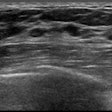Scientists from the National Space Biomedical Research Institute (NSBRI) are developing ultrasound technology that can detect and "push" kidney stones toward the exit of the kidney.
In Doppler mode on a diagnostic ultrasound machine, kidney stones can appear brightly colored and twinkling, known as the twinkling artifact. While working to understand what causes the twinkling artifact image, a research team led by NSBRI investigators Lawrence Crum, PhD, and Michael Bailey, PhD, created specific ultrasound imaging modes for kidney stones.
In an image showing anatomy in grayscale, the stones can appear as one brightly colored stone or multiple colored stones. Once the stones are located, sonographers select a stone to target and then send a focused ultrasound wave of about 0.5 mm in width to move the stone toward the kidney's exit; the stone moves about 1 cm per second, the team said.
The ultrasound technology being developed for NSBRI could have applications beyond kidney stone detection and removal, such as stopping internal bleeding and ablating tumors, according to the researchers. An open-architecture, software-based platform could be developed to use ultrasound for a variety of diagnostic and therapeutic applications, Crum said.



















